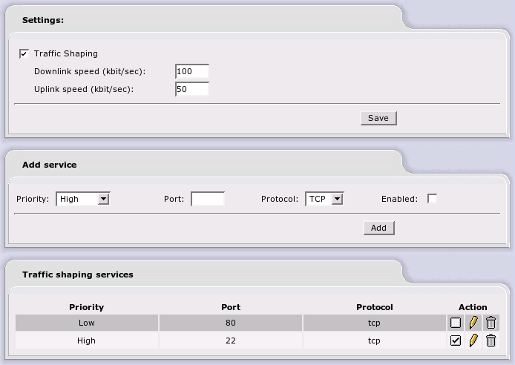At the office we share the same ADSL line for both general web surfing and VoIP, not the greatest situation to sit with of course, but if we have to, we have to. Of course, this does mean that should someone try to make or receive a call at the same time the rest of us are all busy frantically raping the web, sound quality diminishes quite substantially.
The way around this is of course to implement some sort of port prioritizing which will give preference to packets flowing in and out of one particular port compared to data flowing through another. In other words, traffic shaping.
Now IPCop comes with a handy built in traffic shaper in the shape of WonderShaper, which allows you to prioritize either TCP or UDP port traffic by placing specific ports into one of three categories, namely Low, Medium and High. In order to use the system, you first need to gauge your upload and download speeds by using one of the many free services like speedtest.net that are currently out there. Once you have these values plugged in and have enabled Traffic Shaping via the Traffic Shaping menu option, you can then begin to sort specific port traffic into your three priority levels.
For example, interactive traffic like SSH (port 22) and VoIP go into the high priority group while normal web traffic (port 80) is more suited to fall within the medium priority group. Lastly, your non critical port traffic like P2P file sharing packets can safely be dropped in the low priority group. These can all be added to the system via the “Add Service” box which allows you to fill in the necessary details as well as select which protocol to apply the rule to (i.e. TCP or UDP).
And that in a nutshell, is traffic shaping on IPCop. Pretty simple eh? :)
Related Link: http://www.ipcop.org/1.4.0/en/admin/html/services.html#services_shaping
You might also enjoy:
-
It is suicide to run any network connected server or PC without a decent condom, in this case a proper firewall. At last firewall designers have changed the ...
-
If you are a serious web developer (and you happen to be working off a Windows platform), then chances are good that you currently have the excellent Fiddle ...
-
For the most part, the default port for SSH access into a Linux machine is 21. However, many people change this default in the name of security, meaning tha ...
-
What you need before we start:- Manufacturer and Model Name (can be found on the printer case)- IP Address (can usually be found on a label attached to the ...
-
If you are a well established Linux user then you'll already be pretty familiar with the awesome little wget application that gives you a command line inter ...






